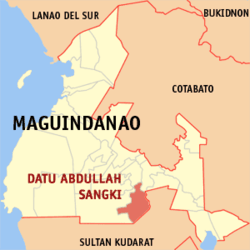Datu Abdullah Sangki, Maguindanao
| Datu Abdullah Sangki | |
|---|---|
| Municipality | |
| Municipality of Datu Abdullah Sangki | |
 Map of Maguindanao with Datu Abdullah Sangki highlighted | |
.svg.png) Datu Abdullah Sangki Location within the Philippines | |
| Coordinates: 6°49′52″N 124°30′26″E / 6.83111°N 124.50722°ECoordinates: 6°49′52″N 124°30′26″E / 6.83111°N 124.50722°E | |
| Country |
|
| Region | Autonomous Region in Muslim Mindanao (ARMM) |
| Province | Maguindanao |
| District | 2nd District |
| Barangays | 10 (see Barangays) |
| Government [1] | |
| • Type | Sangguniang Bayan |
| • Mayor | Mariam Sangki Mangudadatu |
| • Electorate | 11,362 voters (2016) |
| Area [2] | |
| • Total | 220.00 km2 (84.94 sq mi) |
| Population (2015 census)[3] | |
| • Total | 23,878 |
| • Density | 110/km2 (280/sq mi) |
| Time zone | UTC+8 (PST) |
| ZIP code | 9609 |
| PSGC | 153828000 |
| IDD : area code | +63 (0)64 |
| Climate type | Tropical climate |
| Income class | 6th municipal income class |
| Revenue (₱) | 74,250,885.23 (2016) |
| Native languages |
Maguindanao language Tagalog |
Datu Abdullah Sangki, officially the Municipality of Datu Abdullah Sangki, is a 6th class municipality in the province of Maguindanao, Philippines. According to the 2015 census, it has a population of 23,878 people.[3]
The municipality was created under Muslim Mindanao Autonomy Act No. 153, passed by the Regional Legislative Assembly on August 15, 2003 and approved on August 20, 2003,[4] ratified in the plebiscite held on January 3, 2004.[5] It was carved out from its mother town, Ampatuan.
Barangays
Datu Abdullah Sangki is politically subdivided into 10 barangays.[6]
- Banaba
- Dimampao
- Guinibon
- Kaya-kaya
- Mao
- Maranding
- Old Maganoy
- Sugadol
- Talisawa
- Tukanalugong
Demographics
| Population census of Datu Abdullah Sangki | ||
|---|---|---|
| Year | Pop. | ±% p.a. |
| 2007 | 33,259 | — |
| 2010 | 17,079 | −21.54% |
| 2015 | 23,878 | +6.59% |
| Source: Philippine Statistics Authority[3] [7] [8] [9] | ||
References
- ↑ "Municipality". Quezon City, Philippines: Department of the Interior and Local Government. Retrieved 31 May 2013.
- ↑ "Province: Maguindanao". PSGC Interactive. Quezon City, Philippines: Philippine Statistics Authority. Retrieved 12 November 2016.
- 1 2 3 Census of Population (2015). "ARMM – Autonomous Region in Muslim Mindanao". Total Population by Province, City, Municipality and Barangay. PSA. Retrieved 20 June 2016.
- ↑ "Muslim Mindanao Autonomy Act No. 153; An Act Creating the Municipality of Datu Abdullah Sangki in the Province of Maguindanao, Providing Funds Therefor, and for Other Purposes" (PDF). Regional Legislative Assembly, Autonomous Region in Muslim Mindanao. Retrieved 27 January 2016.
- ↑ National Statistical Coordination Board (2004-08-22). "2004 Factsheet (January to July 2004)". Archived from the original on 2006-06-15. Retrieved 2006-06-24.
- ↑ National Statistical Coordination Board. "PSGC Interactive: Municipality/City: DATU ABDULLAH SANGKI". Retrieved 2008-05-19.
- ↑ Census of Population and Housing (2010). "ARMM – Autonomous Region in Muslim Mindanao". Total Population by Province, City, Municipality and Barangay. NSO. Retrieved 29 June 2016.
- ↑ Censuses of Population (1903–2007). "ARMM – Autonomous Region in Muslim Mindanao". Table 1. Population Enumerated in Various Censuses by Province/Highly Urbanized City: 1903 to 2007. NSO.
- ↑ "Province of Maguindanao". Municipality Population Data. Local Water Utilities Administration Research Division. Retrieved 17 December 2016.
External links
This article is issued from
Wikipedia.
The text is licensed under Creative Commons - Attribution - Sharealike.
Additional terms may apply for the media files.